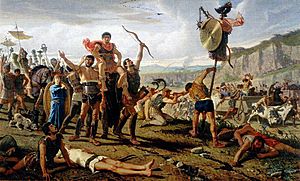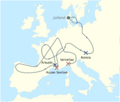Cimbrian War facts for kids
Quick facts for kids Cimbrian War |
|||||||
|---|---|---|---|---|---|---|---|
 Supposed migrations of the Cimbri and the Teutons: |
|||||||
|
|||||||
| Belligerents | |||||||
Celtiberians |
Cimbri Teutones Ambrones Tigurini |
||||||
| Commanders and leaders | |||||||
| Gaius Marius Quintus Lutatius Catulus Quintus Servilius Caepio Gnaeus Mallius Maximus Gnaeus Papirius Carbo Lucius Cassius Longinus † Lucius Calpurnius Piso † Marcus Junius Silanus |
Boiorix † (Cimbri) Lugius † (Cimbri) Claodicus Caesorix Divico (Tigurini) Teutobod |
||||||
The Cimbrian War (113–101 BC) was a big conflict between the Roman Republic and several Germanic and Celtic tribes. These tribes included the Cimbri, Teutones, Ambrones, and Tigurini. They traveled from the Jutland peninsula (modern-day Denmark) and moved into lands controlled by Rome and its friends.
This war was a huge deal for Rome. It was the first time since the Second Punic War that Italy and the city of Rome itself faced such a serious threat. The war also helped a Roman general named Gaius Marius become very famous. He changed how the Roman army worked, making it stronger and more effective.
Rome eventually won the war. The Germanic tribes had caused Rome some of its worst defeats, like at the battles of Arausio and Noreia. But in the end, the Romans almost completely wiped out these tribes at the battles of Aquae Sextiae and Vercellae.
Contents
Why Did the Cimbri and Teutones Migrate?
Around 120–115 BC, some Roman stories say the Cimbri left their homes near the North Sea. They supposedly moved because of big floods. They traveled southeast and were soon joined by the Teutones, who were possibly related to them.
Together, these tribes defeated other groups like the Scordisci and the Boii. Many people from these defeated groups joined the Cimbri and Teutones. In 113 BC, they reached the Danube River in Noricum. This area was home to the Taurisci, who were allies of Rome. The Taurisci couldn't stop the invaders alone, so they asked Rome for help.
Early Roman Defeats
The next year, a Roman leader called a consul named Gnaeus Papirius Carbo led Roman armies, known as legions, into Noricum. He showed his strength and took a good defensive spot. Carbo demanded that the Cimbri and their friends leave the area right away.
At first, the Cimbri seemed to agree peacefully. But they soon found out that Carbo had planned a surprise attack against them. The Cimbri were furious about this trick. They attacked Carbo's army at the Battle of Noreia and almost completely destroyed it. Carbo himself barely escaped with his life.
After this, Italy was open to attack. But for some reason, the Cimbri and their allies moved west over the Alps mountains and into Gaul (modern-day France). In 109 BC, they invaded a Roman province called Gallia Narbonensis. They defeated the Roman army there, led by Marcus Junius Silanus.
In 107 BC, the Romans lost again. This time, they were defeated by the Tigurini, who were allies of the Cimbri. The Tigurini had joined the Cimbri on their journey through the Alps. In the same year, the Cimbri defeated another Roman army at the Battle of Burdigala (modern-day Bordeaux). They also killed its commander, Consul Lucius Cassius Longinus Ravalla.
The Disaster at Arausio
In 105 BC, Rome decided to end the war once and for all. Two Roman leaders, Consul Gnaeus Mallius Maximus and Proconsul Quintus Servilius Caepio, gathered a massive army. It was the largest force Rome had put together since the Second Punic War. This army had over 80,000 soldiers, plus tens of thousands of support staff.
The two leaders led their armies to the Rhône River near Orange, Vaucluse. But they didn't like or trust each other. So, they set up separate camps on opposite sides of the river. This made their armies easy to attack one by one. Caepio was too confident and attacked without waiting for Maximus's support. His legions were wiped out, and his camp was taken over.
Maximus's troops were now alone and scared. They were easily defeated. Thousands more Romans died trying to defend their poorly placed camp. Only Caepio, Maximus, and a few hundred Romans managed to escape. The Battle of Arausio was one of Rome's most costly defeats ever, even worse than Cannae. For the Cimbri and Teutones, it was a huge victory, but it didn't last.
Instead of marching on Rome right away, the Cimbri went to Hispania (modern-day Spain). There, they faced their first defeat, not from a Roman army, but from a group of Celtiberians. Meanwhile, the Teutones stayed in Gaul. It's still a mystery why they didn't invade Italy after such a big win.
Marius Takes Command of the Roman Army
After the terrible defeat at Arausio, fear spread throughout the Roman Republic. People were terrified, expecting the Cimbri to attack Rome at any moment. In this time of panic, Rome declared an emergency. They ignored their usual rules and elected Gaius Marius as consul for five years in a row. This was very unusual and probably against the law.
Marius was famous for winning a war against Jugurtha of Numidia. Because of the huge loss at Arausio, Marius was given the job of rebuilding the Roman armies in Gaul from scratch. He used experienced soldiers from the previous year as a core group. Marius also got permission to let people without much property join the army. With his reputation for winning, he raised an army of about 30,000 Romans and 40,000 Italian allies.
He set up a base near the town of Aquae Sextiae (modern Aix-en-Provence) and trained his soldiers. During his time as consul, Marius worked hard. He trained his troops, built a network of spies, and talked with the Gallic tribes near the Roman borders.
The Roman Senate and people were so scared that they gave Marius all the power he needed to build his army. The Cimbri and Teutones made a big mistake by not following up on their victory. This gave Marius the time he needed to prepare his army. Soon, the Germanic tribes would face a well-organized and trained army led by a very smart and tough commander.
The Turning Point: Roman Victories
By 102 BC, Marius was ready to fight the Cimbri. The Cimbri, after having trouble in Spain, had returned north to Gaul. There, they joined up with the Teutones. After this reunion, the Germanic tribes decided to finally move south into Italy, which they had avoided before.
They marched south through Switzerland and Savoy. Their army grew even bigger as some tribes like the Helvetians (especially the Tigurini) and the Ambrones joined them. Before reaching Italy, the Germans decided to split their forces. The Teutones, with the Ambrones and Tigurini, would move from the west along the coast road. The Cimbri would march east and enter Italy through the Julian and Carnic Alps.
When Marius heard about their plans, he moved to Valence. He set up his camp where the Isère and Rhône rivers meet. From there, he could watch and block the Teutones' march. When the Teutones arrived, they tried to force Marius into a battle, but he refused. They attacked the Roman camp but were pushed back.
The Teutones grew impatient with Marius's calm approach. They finally decided to just march past him into Italy. There were so many of them that it reportedly took six whole days for their army to pass his camp. They even made fun of the Romans, asking what message they wanted them to give to their wives. Marius followed carefully, keeping his distance but watching their every move.
A few days later, a small fight turned into a big battle with the Ambrones. For some reason, they had camped separately from the Teutones. The Ambrones were defeated with heavy losses and ran to their Teutonic allies. The Teutones stopped their march south and waited for Marius near Aquae Sextiae. This was good for Marius because with the enemy staying still, he could scout the area and choose the best battleground.
In the battle that followed, Marius tricked the Teutones and their allies into attacking him while his army was on high ground. As they attacked, a special group of five Roman units that Marius had hidden in a nearby forest ambushed them from behind. The Teutones were completely defeated and killed. Their king, Teutobod, was captured and put in Roman chains.
But Aquae Sextiae only balanced the score. The Teutones were gone, but the Cimbri were still a very strong threat.
In 101 BC, the Cimbri returned to Gaul and got ready for the final part of their fight with Rome. For the first time, they went through the Alpine mountain passes into northern Italy. Marius's co-consul that year, Quintus Lutatius Catulus, had failed to protect these passes. Catulus pulled his army back behind the Po River, leaving the countryside open to the invaders.
But the Cimbri took their time enjoying the rich region. This gave Marius enough time to arrive with more soldiers. These were the same victorious legions from Aquae Sextiae. The final battle happened at Vercellae, near where the Sesia River meets the Po, on a flat area called the Raudine Plain. Here, the strength of the new Roman legions and their cavalry was clearly shown. The Cimbri were almost completely destroyed in this terrible defeat. Their main leaders, Boiorix and Lugius, both died.
What Happened After the War?
The Cimbri were not completely wiped out from history. Some of their allies, the Boii, mixed with them and settled in southern Gaul and Germania. These groups were still there to meet Julius Caesar, Marius's nephew, many years later during his conquests. Some of the Cimbrian captives who survived are said to have been among the rebelling gladiators in the Third Servile War.
The Cimbrian War had a big and lasting impact on Rome's politics. The end of the war started a rivalry between Marius and Sulla. This rivalry eventually led to the first of Rome's great civil wars.
Also, after the final victory at Vercellae, Marius did something important. Without asking the Senate first, he gave Roman citizenship to two groups of his Italian allied soldiers. He reportedly said that in the noise of battle, he couldn't tell the difference between the voices of Romans and their Italian allies.
Because of this, Italian legions slowly became Roman legions. The allied cities in Italy began to demand more say in how the Roman Republic was run. This eventually led to the Social War.
Images for kids






